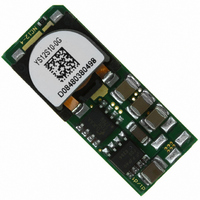YS12S10-0G POWER ONE, YS12S10-0G Datasheet - Page 7

YS12S10-0G
Manufacturer Part Number
YS12S10-0G
Description
CONVERTER DC-DC 12V 10A SMD
Manufacturer
POWER ONE
Series
Yr
Type
Point of Load (POL) Non-Isolatedr
Datasheet
1.YS12S10-0G.pdf
(27 pages)
Specifications of YS12S10-0G
Output
0.75 ~ 5.5V
Number Of Outputs
1
Power (watts)
55W
Mounting Type
Surface Mount
Voltage - Input
9.6 ~ 14V
Package / Case
6-DIP SMD Module
1st Output
0.75 ~ 5.5 VDC @ 10A
Size / Dimension
1.30" L x 0.53" W x 0.31" H (33mm x 13.5mm x 7.9mm)
Power (watts) - Rated
55W
Operating Temperature
-40°C ~ 85°C
Efficiency
95%
Approvals
cUL, EN, UL
Package
6SMD
Output Current
10 A
Output Voltage
0.7525 to 5.5 V
Input Voltage
12 V
Output Power
55 W
Input Voltage Range
9.6 V to 14 V
Input Voltage (nominal)
12 V
Output Voltage (channel 1)
0.7525 V to 5.5 V
Output Current (channel 1)
10 A
Package / Case Size
33.02 mm x 13.46 mm x 7.98 mm
Output Type
Regulated
Product
Non-Isolated / POL
Lead Free Status / RoHS Status
Lead free / RoHS Compliant
3rd Output
-
2nd Output
-
Lead Free Status / Rohs Status
Lead free / RoHS Compliant
Other names
179-2371-2
Available stocks
Company
Part Number
Manufacturer
Quantity
Price
Company:
Part Number:
YS12S10-0G
Manufacturer:
PowerOne
Quantity:
100
Company:
Part Number:
YS12S10-0G
Manufacturer:
STM
Quantity:
4 914
Protection Features
Input Undervoltage Lockout
Input undervoltage lockout is standard with this
converter. The converter will shut down when the
input voltage drops below a pre-determined voltage;
it will start automatically when Vin returns to a
specified range.
The input voltage must be typically 9.0 V for the
converter to turn on. Once the converter has been
turned on, it will shut off when the input voltage
drops below typically 8.5 V.
Output Overcurrent Protection (OCP)
The converter is protected against overcurrent and
short circuit conditions. Upon sensing an overcurrent
condition, the converter will enter hiccup mode. Once
overload or short circuit condition is removed, Vout
will return to nominal value.
Overtemperature Protection (OTP)
The
overtemperature condition to protect itself from
overheating caused by operation outside the thermal
derating curves, or operation in abnormal conditions
such as system fan failure. After the converter has
cooled to a safe operating temperature, it will
automatically restart.
Safety Requirements
The
International safety regulatory requirements per
UL60950 and EN60950. The maximum DC voltage
between any two pins is Vin under all operating
conditions. Therefore, the unit has ELV (extra low
voltage) output; it meets SELV requirements under
the condition that all input voltages are ELV.
The converter is not internally fused. To comply with
safety agencies’ requirements, a recognized fuse
with a maximum rating of 15 Amps must be used in
series with the input line.
Characterization
General Information
The converter has been characterized for many
operational aspects, to include thermal derating
(maximum load current as a function of ambient
temperature and airflow) for vertical and horizontal
mountings,
parameters, output ripple and noise, transient
response to load step-change, overload, and short
circuit.
MCD10206 Rev. 1.0, 24-Jun-10
converter
converter
efficiency,
meets
will
shut
startup
North
9.6-14 VDC Input; 0.7525-5.5 VDC Programmable @ 10 A
down
and
American
under
shutdown
and
an
Page 7 of 27
YS12S10 DC-DC Converter Data Sheet
The figures are numbered as Fig. x.y, where x
indicates the different output voltages, and y
associates with specific plots (y = 1 for the vertical
thermal derating, …). For example, Fig. x.1 will refer
to the vertical thermal derating for all the output
voltages in general.
The following pages contain specific plots or
waveforms associated with the converter. Additional
comments for specific data are provided below.
Test Conditions
All data presented were taken with the converter
soldered to a test board, specifically a 0.060” thick
printed wiring board (PWB) with four layers. The top
and bottom layers were not metalized. The two inner
layers, comprised of two-ounce copper, were used to
provide traces for connectivity to the converter.
The lack of metalization on the outer layers as well
as the limited thermal connection ensured that heat
transfer from the converter to the PWB was
minimized. This provides a worst-case but consistent
scenario for thermal derating purposes.
All measurements requiring airflow were made in the
vertical and horizontal wind tunnels using Infrared
(IR)
thermometry.
Ensuring components on the converter do not
exceed their ratings is important to maintaining high
reliability. If one anticipates operating the converter
at or close to the maximum loads specified in the
derating curves, it is prudent to check actual
operating
Thermographic
capability is not available, then thermocouples may
be used. The use of AWG #40 gauge thermocouples
is recommended to ensure measurement accuracy.
Careful routing of the thermocouple leads will further
minimize measurement error. Refer to Fig. D for the
optimum measuring thermocouple location.
Fig. D: Location of the thermocouple for thermal testing.
thermography
www.power-one.com
temperatures
imaging
and
is
in
thermocouples
preferable;
the
application.
if
this
for













